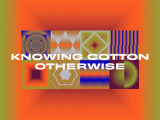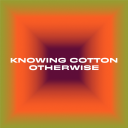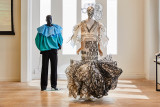Stay in the know on all smart updates of your favorite topics.
Knowing Cotton Otherwise - Flipping the Script

Cotton is perhaps the world's most well-known fabric, however, many stories behind cotton are lesser known. These untold and sometimes unexpected perspectives have been collected and brought together in the exhibition, Knowing Cotton Otherwise.
In the third and final chapter, Flipping the Script, designers Nsimba Valene Lontanga and Angelo Carlos Marcus Elizabeth take you on a journey through their heritage and culture while challenging you to reimagine fundamental concepts within the realm of fashion and design.
The exhibition unpacks and brings into question established ideas of 'classic' and 'basic' style staples, as well as redefining 'typically African' design and print. What happens when we reconsider our preconceived ideas of what cotton represents around the world?
Knowing Cotton Otherwise is open to the public until 16 October 2023 at the Fashion for Good Museum, Rokin 102, Amsterdam.
Exhibition: Knowing Cotton Otherwise - Bodies of Work

Last year we introduced Knowing Cotton Otherwise, a multidisciplinary exhibition, covering various aspects of this versatile fibre — from its burdened history to sustainable initiatives and innovative implementations worldwide. Through this new chapter, Bodies of Work, the experience of human bodies entangled in (forced) labour in the story of cotton are amplified. With the addition of works by Sha’Mira Covington and Tricia Nganga Mokosi, the exhibition explores some of the complex issues related to cotton's history and the use and re-use of this fabric in fashion and tech. The exhibition also showcases innovative technologies in material traceability and natural fibre recycling from Fashion for Good Innovators Oritain and Natural Fiber Welding. The continuation of the exhibition invites you to consider your own body as you move through space as a spectator in the narrative. How do you position yourself within the community of stories presented here?
Knowing Cotton Otherwise

Exhibition Knowing Cotton Otherwise
Cotton is perhaps the world's most well-known fabric, however, many stories behind cotton are less known. These untold and sometimes unexpected perspectives have been collected and brought together in the exhibition, Knowing Cotton Otherwise. Centred on collectivity and community, local artists have been invited to present work that connects and intersects with different themes relating to the story of cotton. By mixing styles and stories, Knowing Cotton Otherwise creates a multifaceted experience, inviting you to reflect, question, play and wonder.
Fashion, art and social change
Built around different themes telling the story of cotton, the exhibition highlights the relationship between cotton and the fashion industry, the role of cotton in an increasingly intertwined web of global cultures, and the sustainable innovations driving its circular transformation. The exhibition provides questions such as where does cotton come from? How is it grown? What is the future of cotton and the role of innovation? How should we relate to the more questionable aspects of cotton, from its history of forced migration to more modern-day challenges? And how can we celebrate cotton, the connections it creates and the opportunities around it?
Collectivity and Community
Knowing Cotton Otherwise is presented in different phases throughout the year in which the exhibition grows and changes. The first phase features artists Benoît Gilles Michel, Caithlin Courtney Chong, Mario Gonsalves, Niño Divino, Noah Cohen, Nsimba Valene and Tasio Bidegain as well as the collectives OSSO Archive, Studio Papa and The Gang is Beautiful. The exhibition also showcases innovative technologies in material traceability and dyeing from Fashion for Good Innovators Oritain and Officina39. Knowing Cotton Otherwise invites you to question the content presented, examine your ideas and engage together in a process of self-reflection and critical consideration.
Expo: "Fashion Week: A New Era"

The expo: 'Fashion Week: A New Era' celebrates fashion through the years and explores how this phenomenon developed over time. How does the event influence the fashion industry? And what does the future hold for fashion week?
Every year during Fashion Week the latest fashion is shown on catwalks in Paris, Milan and New York and other metropoles across the globe. This iconic event has a major impact on the fashion industry and on our own wardrobes. In 'Fashion Week: A New Era', the Fashion for Good Museum unpacks the Fashion Week, delving into its past, present and future. View historic looks from the runways of Balenciaga, Versace, Moschino and many more; discover the innovative work of Dutch fashion designer Ronald van der Kemp and digital fashion house The Fabricant.
Small scale Waste Transformer | Organic waste into value on your own site

A Waste Transformer is a small-scale anaerobic digester which organisations place on their own site, transforming their own organic waste into green energy (biogas, electricity, heat) and fertilizer. A circular economy around your own waste streams.
A Waste Transformer is the perfect solution for organisations which produce between 600KG and 3600KG of organic waste per day. Normally waste is a cost, with a Waste Transformer it becomes a source of positive (financial) change. It is a high tech installation, but with low tech daily usability. This Waste Transformer in Amsterdam, transforms the organic waste from 10 restaurants, a hotel and micro brewery into green energy. The fertilizer is given back to the park, and the energy created turning the lights on in the restaurants.
A Waste Transformer is suitable in many situations, worldwide. It provides jobs for people with a distance to the labour market, it reduces greatly your waste handling costs, and it creates green energy and fertilizer. Then we have not even discussed the positive stories each Waste Transformer owner can share with their clients and stakeholders.
Upcycling waste, on your own premises.
By the way. A Waste Transformer is a closed systems, which means you don't smell it once it is inside the Transformer. Good energy!
Stay up to date
Get notified about new updates, opportunities or events that match your interests.

